Did you know that before the creation of the United States Air Force (USAF), the United States Army had an aviation unit for forty years?
Did you know that the unit had multiple squadrons that performed various functions to assist the United States Army in air combat?
Proof of the aviation unit’s existence can be found with this Model 1937 wool army shirt. It was manufactured by the Southern Manufacturing Co., Inc. and distributed by the Philadelphia Quartermaster Depot. The manufacturer obtained the contract to make these shirts in September 1941.
On the shirt’s left arm, there is a patch. This patch signifies the United States Army’s air division during World War II.
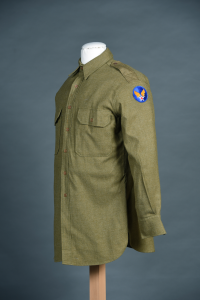
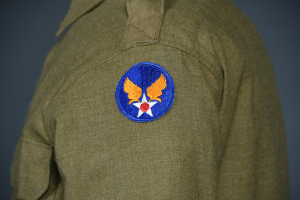
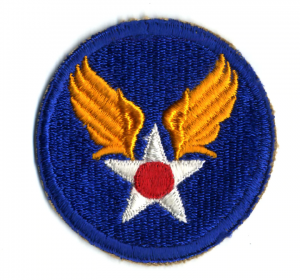
Model 1937 Wool army shirt manufactured by the Southern Manufacturing Co., Inc. The owner’s name, Freeman, is handwritten on the interior, with the number F-5338 stamped in black ink. (Fashion Archives and Museum, S1983-04-009, donated by A. Commerer)
Military patches have the ability to show unit, rank, and order within a country’s military. Patches tell the stories about the soldiers who wear them and the soldiers who came before them.
Embroidered military patches were first worn in the 1800s by British soldiers, but were only worn by officers to signify their higher rank. Patches became an effective way to distinguish between divisions in military units, and the idea soon spread to America. Before the Civil War, military uniforms were remarkably unadorned and void of any decoration. It wasn’t until World War I that a general officially authorized the limited use of military patches on uniforms.
Whether you’re a high school student or a military history buff, this exhibit presents the history and significance of the United States Army’s aviation patches worn before the creation of the USAF.
The United States Army… in the Sky
Early Days
- August 1907 – The United States Army created an aviation unit.
- August 1908-1909 – The first airplane, Airplane No. 1, was tested.
1st Reconnaissance Squadron/1st Aero Squadron
- March 1913 – Men and equipment were assembled for the 1st Provisional Aero Squadron.
- December 1913 – General orders redesignated the unit as the 1st Aero Squadron. This was the first military unit devoted exclusively to aviation, today designated the 1st Reconnaissance Squadron and has remained continuously active since its creation.
- June 1918 – The 1st Aero Squadron adopted the American flag as its squadron emblem and the insignia was painted on the fuselage of all of its aircraft.
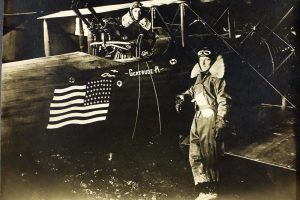
World War I Lt. Arthur Coyle and Lt. Easterbrook Salmson, 1st Aero Sq,1st Reconnaissance Squadron/1st Aero Squadron Insignia seen on the plane (Courtesy of San Diego Air and Space Museum Archives)
- During this first US military air action, the 1st Aero Squadron flew 346 hours on 540 flights and covered more than 19,300 miles, performing aerial reconnaissance and photography, and transporting mail and official dispatches. More importantly, the military learned that the airplane could no longer be considered an experiment or an oddity, but could become a useful military tool.
- 1st Aero Squadron pilots recorded 13 aerial victories during the war, commemorated by 13 Maltese crosses encircling their squadron emblem.
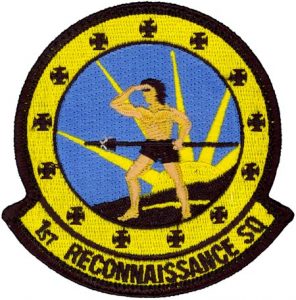
1st Reconnaissance Squadron Patch (Courtesy of Flightline Insignia)
World War I
- May 1918 – President Woodrow Wilson signed an executive order, which transferred aviation to the Bureau of Aircraft Production and the Division of Military Aeronautics. The War Department recognized these agencies as the Air Service of the United States Army.
90th Fighter Squadron/Dicemen & 94th Fighter Squadron/Hat in the Ring
- August 1917 – Organized as the 90th Aero Squadron & 94th Aero Squadron.
- World War I – Both fought on the Western Front in France.
- Organized as the 94th Aero Squadron at Kelly Field, Texas on 20 August 1917, the 94th Fighter Squadron began its long and prestigious history in air warfare, which includes the first patrol flown by an American‑trained squadron in France during World War I, on March 6, 1918, flying the Nieuport 28.
- During World War II, the 90th Fighter Squadron earned the Distinguished Unit Citation and the Presidential Unit Citation for its services in the Pacific Theater of Operations as part of Fifth Air Force.
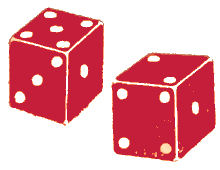
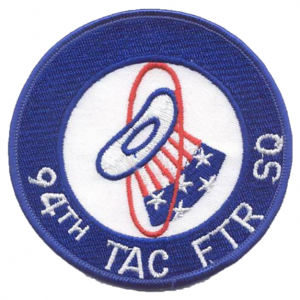
90th Aero Squadron/Dicemen earliest emblem- now there are MANY variants; 94th Fighter Squadron/Hat in the Ring patch (Courtesy of Dr. B. Bohleke)
- The 90th Aero Squadron carried out many reconnaissances, engaged in 23 combats, and relieved official confirmation for 7 aerial victories. Its first commander, First Lieutenant William G. Schauffler, designed the 90th’s Pair o’ Dice emblem. The group’s lucky “Seven Up” emblem of red dice with white dots reading “7” no matter which way it was tallied.
- In 1924, in an effort to preserve the heritage of former WWI units, the U.S. Air Service consolidated the lineage and honors of the 103d Aero Squadron with those of 94th. This was a very significant decision that allowed the heritage of the Lafayette Escadrille and 103d Aero Squadron to live on through the 94th. The squadron even utilized the Lakota Indian head, the signature artwork of the Lafayette Escadrille and 103d, as the 94th emblem between WWI and WWII while the “Hat-in-the-Ring” was temporarily unauthorized.
- Dice and Hat in the Ring designs were originally emblems, not patches.
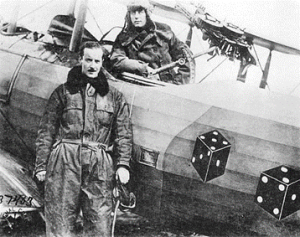
Dicemen Insignia seen on the plane. (Courtesy of Wikipedia)
Between the World Wars
- July 1926 – The Air Corps Act of 1926 changed the name of the Air Service to the Air Corps.
- October 1938 – President Franklin D. Roosevelt acknowledged the growing importance of airpower, recognizing that the United States might be drawn into a European war. Assured of a favorable reception in the White House, the Air Corps prepared plans for a force of some 7,000 aircraft.
World War II
- March 9, 1942 – The War Department created three the Army Ground Forces, the Services of Supply, and the Army Air Forces.
- March 1946 – The War Department redesignated the Strategic Air Command as well as created the Air Defense Command and the Tactical Air Command. These three commands provided the framework for an independent airforce.
101st Airborne Division
- Established in August 1942.
- June 6, 1944 – First Allied Soldiers to land in France during the Battle of Normandy, also known as D-Day.
- The Screaming Eagle insignia of the 101st Airborne Division is perhaps the most recognized shoulder sleeve insignia in the United States Army. However, the history and symbolism of the patch is often forgotten. The eagle on the shoulder is not just any American Bald Eagle, but instead, it commemorates the most famous animal mascot that ever served in the United States Army, dating all the way back to the Civil War.
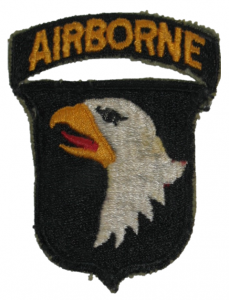
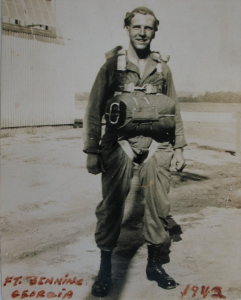
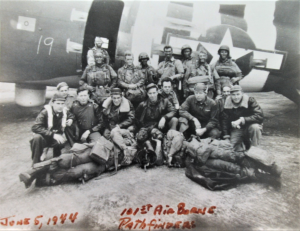
Henry Bohleke’s 101st Airborne patch, front, early issue; Pvt. Henry Bohleke in Parachute training in Georgia for 101st Airborne; Sgt Henry Bohleke, standing in front of star insignia on D-Day minus 1, Pathfinder C-47 number 19 (Courtesy of Dr. B. Bohleke)
99th, 301, & 332 Fighter Squadrons/The Tuskegee Airmen
- Due to segregation within the military, black men fought in all-black squadrons.
- World War II – Their primary missions were to escort bombers striking targets in Southern Europe.
- 1948 – President Harry Truman passed Executive Order No. 9981, which allowed for equal treatment and opportunity in the military.
- The history of the 332d originated with the Tuskegee Airmen, the popular name of a group of African-American military pilots who fought in World War II. The name encompassed the navigators, bombardiers, mechanics, instructors, crew chiefs, nurses, cooks, and other support personnel for the pilots.
- Tuskegee Airmen overcame segregation and prejudice to become one of the most highly respected fighter groups of World War II.
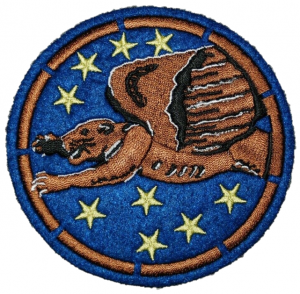
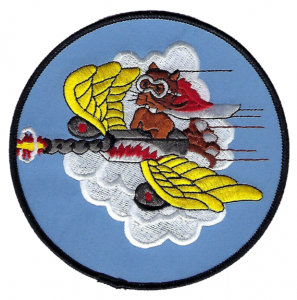
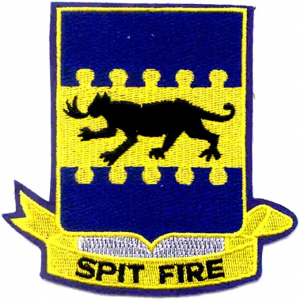
99th Fighter Squadron emblem – Tuskegee Airmen, 332d Fighter Group; 301st Fighter Squadron emblem – Tuskegee Airmen, 332d Fighter Group; 332nd Fighter group DUI (Distinctive Unit Insignia), heraldry in pin form (Courtesy of Dr. B. Bohleke)
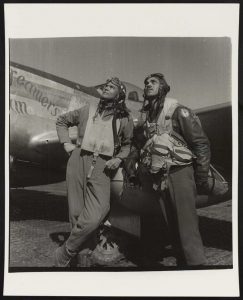
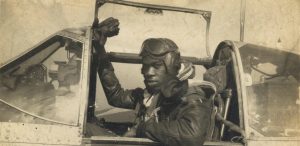
Tuskegee Airmen Benjamin O Davis, left, and Edward C Gleed (wearing 15th Air Force patch), photographed at an airbase at Ramitelli, Italy (Courtesy of Toni Frissell/Library of Congress); Decorated Tuskegee pilot Bertram W Wilson died in 2002 and is buried in Arlington Cemetery (Courtesy of Cheo Hodari Coker [Private Collection]).
509th Composite Group
- October of 1943 – Project Silverplate, which focused on designing the planes to carry the bomb, was started.
- August 6 and 9 – Airmen of the 509th flew from Tinian Island to Hiroshima and Nagasaki, carrying the Little Boy and Fat Man atomic bombs.
- Did not have its own patch during World War II, only after.
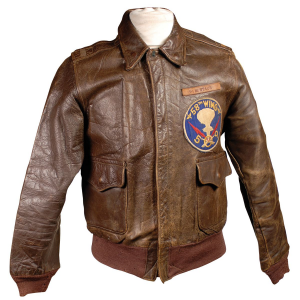

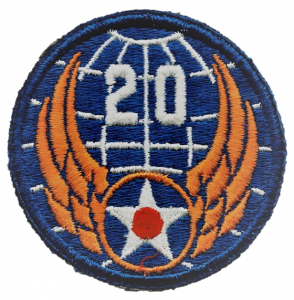
509th emblem on leather flight jacket after WWII (Type A-2 leather flight jacket belonging to 58th Wing 509th Composite Group member W. M. Staub); Crew of B-29 named ‘Full House’, 509th Composite Group, USAAF; 20th Air Force patch, which was the strategic air arm that bombed Japan with B-29s (Courtesy of Dr. B. Bohleke)
The Creation of the United States Air Force
- July 1947 – The National Security Act of 1947 officially established the USAF.
- It is the second youngest branch of the U.S. Armed Forces and the fourth in order of precedence.
Additional Resources:


















